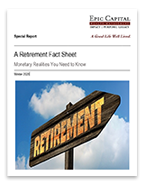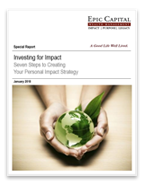Can You Borrow Money From Your 401(k) Plan?
Nov 8, 2023
 If you have a 401(k) plan at work and need some cash, you might be tempted to borrow or withdraw money from it. But keep in mind that the purpose of a 401(k) is to save for retirement. Take money out of it now, and you’ll risk running out of money during retirement. You may also face stiff tax consequences and penalties for withdrawing money before age 59½. Still, if you’re facing a financial emergency — for instance, your child’s college tuition is almost due and your 401(k) is your only source of available funds — borrowing or withdrawing money from your 401(k) may be your only option.
If you have a 401(k) plan at work and need some cash, you might be tempted to borrow or withdraw money from it. But keep in mind that the purpose of a 401(k) is to save for retirement. Take money out of it now, and you’ll risk running out of money during retirement. You may also face stiff tax consequences and penalties for withdrawing money before age 59½. Still, if you’re facing a financial emergency — for instance, your child’s college tuition is almost due and your 401(k) is your only source of available funds — borrowing or withdrawing money from your 401(k) may be your only option.
Plan loans
To find out if you’re allowed to borrow from your 401(k) plan and under what circumstances, check with your plan’s administrator or read your summary plan description. Some employers allow 401(k) loans only in cases of financial hardship, but you may be able to borrow money to buy a car, to improve your home, or to use for other purposes.
Generally, obtaining a 401(k) loan is easy — there’s little paperwork, and there’s no credit check. The fees are limited, too — you may be charged a small processing fee, but that’s generally it.
How much can you borrow?
No matter how much you have in your 401(k) plan, you probably won’t be able to borrow the entire sum. Generally, you can’t borrow more than $50,000 or one-half of your vested plan benefits, whichever is less. (An exception applies if your account value is less than $20,000; in this case, you may be able to borrow up to $10,000, even if this is your entire balance.) Your plan may also allow you to borrow up to $100,000 (or 100% of your vested plan benefits, whichever is less) if used for recovery from a federally-declared disaster.
What are the requirements for repaying the loan?
Typically, you have to repay money you’ve borrowed from your 401(k) within five years by making regular payments of principal and interest at least quarterly, often through payroll deduction. However, if you use the funds to purchase a primary residence, you may have a much longer period of time to repay the loan.
Make sure you follow to the letter the repayment requirements for your loan. If you don’t repay the loan as required, the money you borrowed will be considered a taxable distribution. If you’re under age 59½, you’ll owe a 10% federal penalty tax, as well as regular income tax, on the outstanding loan balance (other than the portion that represents any after-tax or Roth contributions you’ve made to the plan).
What are the advantages of borrowing money from your 401(k)?
- You won’t pay taxes and penalties on the amount you borrow, as long as the loan is repaid on time
- Interest rates on 401(k) plan loans must be consistent with the rates charged by banks and other commercial institutions for similar loans
- In most cases, the interest you pay on borrowed funds is credited to your own plan account; you pay interest to yourself, not to a bank or other lender
What are the disadvantages of borrowing money from your 401(k)?
- If you don’t repay your plan loan when required, it will generally be treated as a taxable distribution.
- If you leave your employer’s service (whether voluntarily or not) and still have an outstanding balance on a plan loan, the outstanding amount of the loan will be considered a distribution. You’ll usually be required to repay the amount in full [or roll over the amount to another 401(k) plan or IRA] by the tax filing deadline (including extensions) of the year following the year the amount is determined to be a distribution (i.e., the year you leave your employer). Otherwise, the outstanding balance will be treated as a taxable distribution, and you’ll owe a 10% penalty tax (if you’re under age 59½) in addition to regular income taxes.
- Loan interest is generally not tax deductible (unless the loan is secured by your principal residence).
- In most cases, the amount you borrow is removed from your 401(k) plan account, and your loan payments are credited back to your account. You’ll lose out on any tax-deferred (or, in the case of Roth accounts, potentially tax-free) investment earnings that may have accrued on the borrowed funds had they remained in your 401(k) plan account.
- Loan payments are made with after-tax dollars.
Hardship withdrawals
Your 401(k) plan may have a provision that allows you to withdraw money from the plan while you’re still employed if you can demonstrate “heavy and immediate” financial need, have exhausted all other available distribution options (and, possibly, loan options) from your retirement plans, and have no other resources you can use to meet that need (e.g., you can’t borrow from a commercial lender and you have no other available savings). It’s up to your employer to determine which financial needs qualify. Many employers allow hardship withdrawals only for the following reasons:
- To pay the medical expenses of you, your spouse, your children, your other dependents, or your primary beneficiary
- To pay the burial or funeral expenses of your parent, your spouse, your children, your other dependents, or your primary beneficiary
- To pay a maximum of 12 months worth of tuition and related educational expenses for post-secondary education for you, your spouse, your children, your other dependents, or your plan beneficiary
- To pay costs related to the purchase of your principal residence
- To make payments to prevent eviction from or foreclosure on your principal residence
- To pay expenses for the repair of damage to your principal residence after certain casualty losses
- To pay expenses and losses (including loss of income) incurred as a result of a disaster declared by the Federal Emergency Management Agency, such as a hurricane or wildfire (provided the participant’s principal residence or place of employment is located in the federally declared disaster area)1
- If you are terminally ill and a physician certifies that your illness or condition is reasonably expected to result in death within 84 months2
Note: You may also be allowed to withdraw funds to pay income tax and/or penalties on the hardship withdrawal itself, if these are due.
Your employer may require that you certify your need for a hardship withdrawal in writing. and certify that you have experienced .
How much can you withdraw?
Depending on plan rules, you may be able to withdraw your contributions, safe harbor employer contributions, and your employer’s qualified nonelective and matching contributions, as well as earnings on those contributions. Check with your plan administrator for more information on the rules that apply to withdrawals from your 401(k) plan.
What are the advantages of withdrawing money from your 401(k) in cases of hardship?
The option to take a hardship withdrawal can come in very handy if you really need money and you have no other assets to draw on, and your plan does not allow loans (or if you can’t afford to make loan payments).
What are the disadvantages of withdrawing money from your 401(k) in cases of hardship?
- Taking a hardship withdrawal will reduce the size of your retirement nest egg, and the funds you withdraw will no longer grow tax deferred.
- Hardship withdrawals are generally subject to federal (and possibly state) income tax. A 10% federal penalty tax may also apply if you’re under age 59½. [If you make a hardship withdrawal of your Roth 401(k) contributions, only the portion of the withdrawal representing earnings will be subject to tax and penalties.]1-2
What else do I need to know?
If you are a reservist called to active duty after September 11, 2001, special rules may apply to you.
1 Your employer may offer penalty-free qualified disaster recovery distributions (QDRDs) to retirement plan participants affected by federally-declared disasters, up to a maximum of $22,000 per disaster.
2The entire 401(k) plan balance may be eligible for penalty-free distributions.
More Insights
You don’t want to pay more in federal income tax than you have to. With that in mind, here are five things to consider when it comes to keeping more of your income.
There’s a subjective uncertainty associated with financial wellness. Are you financially fit? And if so, how fit are you? While there is no clearly defined threshold for answering affirmatively, much less grading your level of fitness, there are baseline elements associated with financial fitness. To make sure that you’re on the right track, develop a … Continue reading “Basics of Financial Fitness”
After a strong first quarter for stocks, some April showers rained down as the S&P 500 fell about 4% last month. Hopefully those showers will bring some flowers in May, despite the widely cited stock market adage, “Sell in May and go away.” There is some merit to this old adage because the S&P 500’s … Continue reading “Market Update – Navigating May’s Stock Market Outlook”
Families are one of the great joys in life, and part of the love you show to your family is making sure that their basic needs are met. While that’s only to be expected from birth through the high school years, many households are helping their adult children well into their twenties and beyond at … Continue reading “Retirement and Adult Children”
At some point in our lives, we may inherit a home or another form of real property. In such instances, we need to understand some of the jargon involving inherited real estate. What does “cost basis” mean? What is a “step-up?” What is the home sale tax exclusion, and what kind of tax break does … Continue reading “Explaining the Basis of Inherited Real Estate”
Services
Epic Capital provides the following comprehensive financial planning and investment management services: Learn More >


 Top of Page
Top of Page











